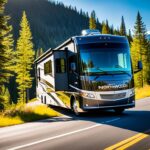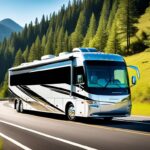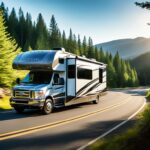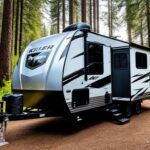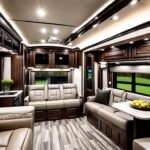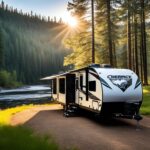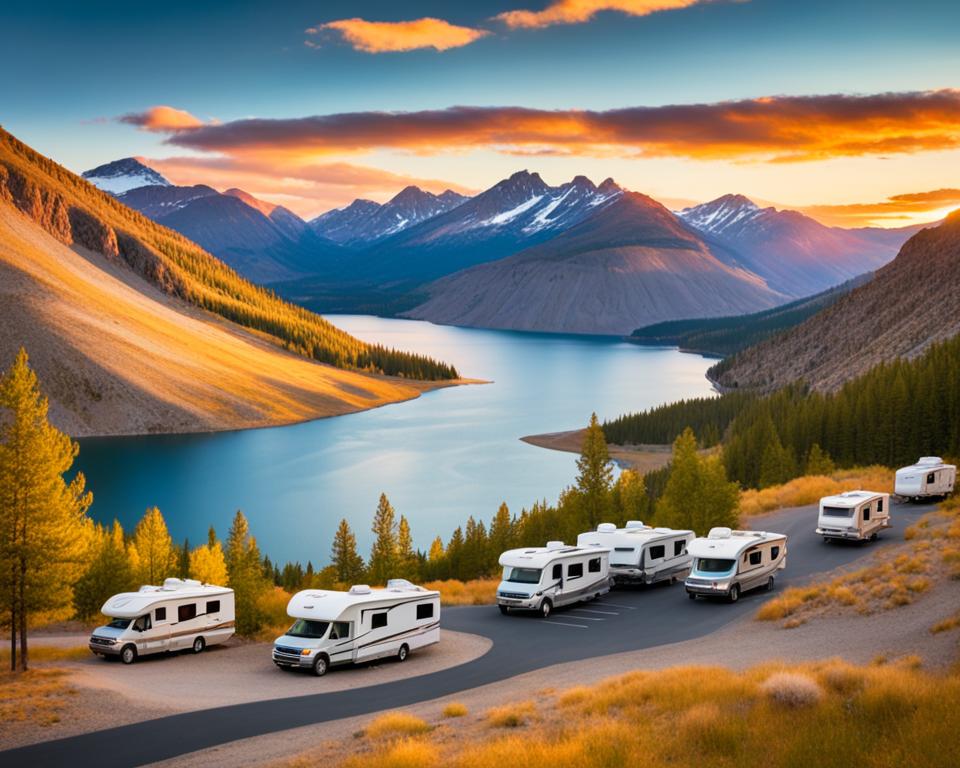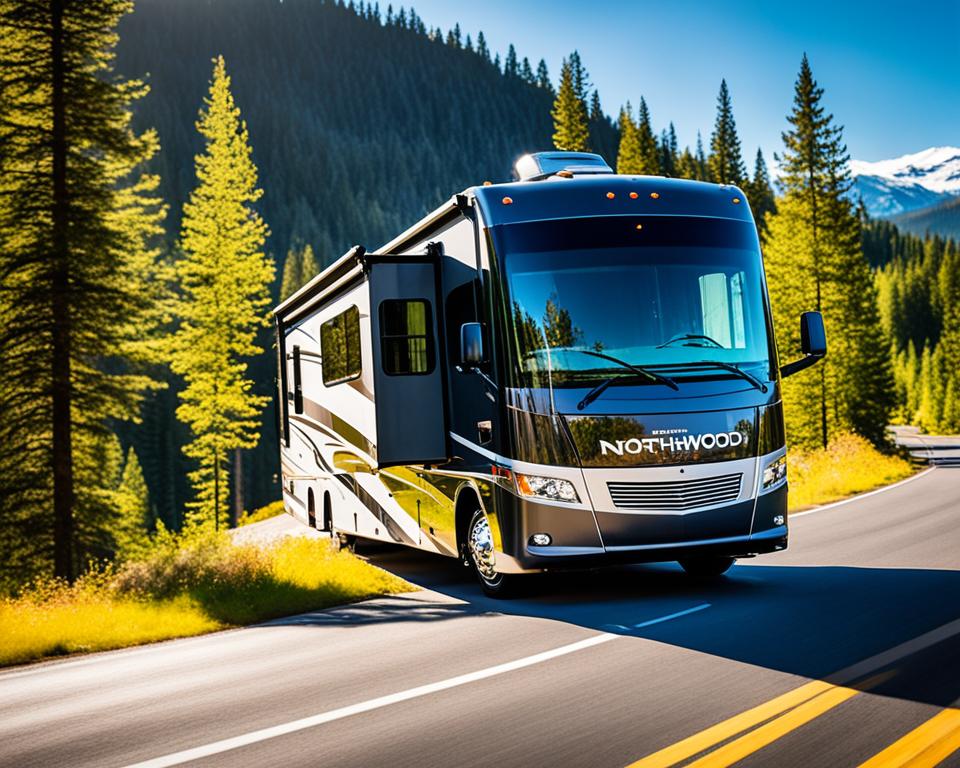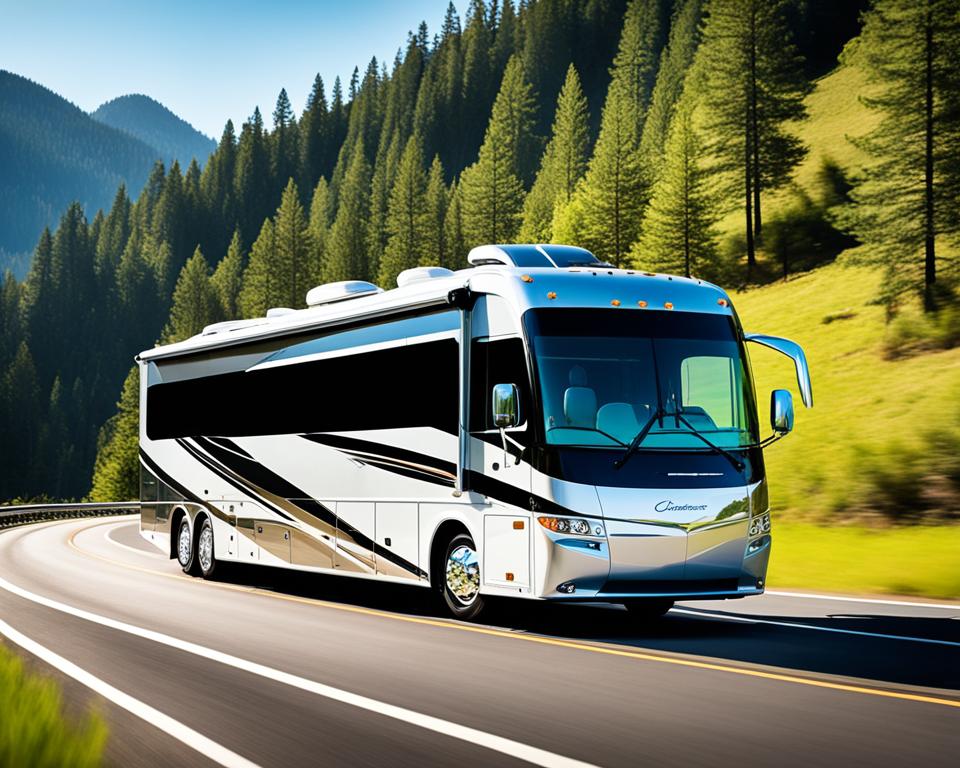Traveling by motorhome has become increasingly popular as people seek vacations that offer a safe and secure way to travel during the pandemic. Motorhomes provide a self-contained living space with all the comforts of home, making them an ideal choice for those who want to avoid crowded airports and hotels. The RV industry has seen a surge in sales, with many new RV enthusiasts entering the market. It’s important to consider motorhome safety when choosing the right vehicle for your travel needs.
Key Takeaways:
- Motorhomes provide a safe and secure way to travel during the pandemic.
- Consider motorhome safety when choosing the right vehicle for your travel needs.
- The RV industry has seen a surge in sales, with many new RV enthusiasts entering the market.
- Motorhomes offer a self-contained living space with all the comforts of home.
- Traveling by motorhome allows you to avoid crowded airports and hotels.
Factors to Consider for Motorhome Safety
When shopping for a motorhome, there are several factors to consider for safety. One important factor is the crash rating of the motorhome. While not all RV manufacturers crash-test their models, some brands, such as Roadtrek, conduct independent crash tests to ensure the quality and safety of their rigs. It’s also important to consider motorhome security features, such as backup and side cameras, that can reduce blind spots and improve overall safety.
In addition to crash ratings and security features, you should also pay attention to maintenance and upkeep. Regular inspections and proper maintenance are crucial to ensure that your motorhome is in top condition and safe to travel in. This includes checking the tires for proper inflation and wear, inspecting the brakes, and ensuring that all safety systems are functioning correctly.
When it comes to safeguarding your motorhome, investing in quality security measures is essential. This could include installing a reliable alarm system or a tracking device to protect your vehicle from theft. Park in well-lit areas and use wheel locks or other physical deterrents when parked for an extended period.
Furthermore, it’s essential to educate yourself about safe driving practices for motorhomes. These vehicles have unique handling characteristics due to their size and weight, requiring drivers to adjust their driving style accordingly. Additionally, familiarize yourself with the specific regulations and laws governing motorhome operation in your state or the areas you plan to visit.
Remember, motorhome safety is a combination of vehicle selection, maintenance, security measures, and responsible driving. By considering all these factors and taking the necessary precautions, you can enjoy a safe and secure travel experience in your motorhome.
| Safety Factors | Description |
|---|---|
| Crash Rating | Check if the motorhome has been crash-tested or has independent crash ratings to ensure its safety in accidents. |
| Security Features | Look for backup and side cameras, alarms, tracking devices, and other security measures to enhance the safety of your motorhome. |
| Maintenance and Upkeep | Regularly inspect and maintain your motorhome to ensure all systems are working properly, including tires, brakes, and safety mechanisms. |
| Safe Driving Practices | Acquire the necessary skills and knowledge for driving a motorhome safely, considering its size, weight, and handling characteristics. |
| Legal Regulations | Familiarize yourself with state and local laws regarding motorhome operation and any additional requirements for safe travel. |
Types of Motorhomes and Safety Ratings
When it comes to choosing a motorhome, understanding the different types and their safety ratings is essential. There are three main types of motorhomes: Class A, Class B, and Class C. Each type offers different features and safety considerations. However, Class B campervans are widely regarded as the safest option due to their stringent safety standards and reliable structural design.
Class B campervans have an advantage when it comes to safety because they are built on tested frames and basic structures made by trusted automotive manufacturers such as Mercedes, Ford, and Dodge. Automakers are required to crash test their vans, which ensures a higher level of safety for Class B motorhomes. These vans typically come equipped with front and side airbags, seatbelts, and stability control systems, providing optimal protection for passengers.
While Class C motorhomes are also safer than Class A, they may not offer the same level of safety as Class B. Class C motorhomes are built on a cutaway chassis and feature an over-the-cab sleeping area. They often come equipped with front and side airbags, seatbelts, and stability control. However, safety features and ratings can vary among different brands and models of Class C motorhomes.
When considering motorhome safety, it’s important to look for specific safety features such as:
- Airbags: Front and side airbags enhance passenger safety in the event of a collision.
- Seatbelts: Properly installed seatbelts ensure that passengers stay securely in place during travel.
- Stability Control: This feature helps maintain control of the motorhome, particularly in challenging road conditions or emergency situations.
Choosing a motorhome with these safety features and the best safety ratings is crucial for a secure and worry-free travel experience. The table below provides a comparison of the safety features, crash ratings, and reliability of different motorhome types:
| Class A Motorhomes | Class B Campervans | Class C Motorhomes | |
|---|---|---|---|
| Safety Features | Varies by brand and model | Front and side airbags, seatbelts, stability control | Front and side airbags, seatbelts, stability control |
| Crash Ratings | Varies by brand and model | High due to tested frames and basic structures | Varies by brand and model |
| Reliability | Reliable, but may have considerations due to size | Reliable and safe | Reliable, but may have variations in safety |
As shown in the table, Class B campervans offer the highest level of safety and reliability among motorhome types. However, other factors such as size, budget, and specific travel needs should also be considered when choosing the right motorhome for you.
Quote:
“The safety features and crash ratings of a motorhome are crucial aspects to consider when making your purchase. Class B campervans, with their tested frames and basic structures, provide exceptional safety for worry-free travels.”
Whether you opt for a Class B campervan or choose a different motorhome type, prioritizing safety features and ratings will ensure a secure and enjoyable journey.
Class A Motorhomes and Safety Considerations
Class A motorhomes offer a wide range of sizes and prices, making them a popular choice for RV enthusiasts. However, it’s important to be aware of the safety considerations associated with these large motorhomes.
Due to their size, Class A motorhomes may be more prone to accidents and rollovers. This is why it’s crucial to prioritize motorhome safety and take certain precautions to ensure a secure travel experience.
One important aspect to consider is tire safety. Always ensure that the tires on your Class A motorhome are properly inflated and regularly inspected. This helps prevent accidents caused by underinflated tires or blowouts, which can be more common in larger vehicles.
Additionally, it’s essential to secure passengers, especially children, with car seats. Class A motorhomes may lack the same level of occupant protection as pickup trucks used to tow travel trailers, so extra precautions are necessary to ensure everyone’s safety on the road.
Learning and practicing the unique driving skills required to safely command a Class A motorhome is also highly recommended. These vehicles have different handling characteristics compared to regular cars, so taking lessons or familiarizing yourself with RV-specific driving techniques can greatly enhance your safety and confidence on the road.
Motorhome Tire Safety Checklist
- Regularly check tire pressure and ensure it matches the manufacturer’s recommendations.
- Inspect tires for any signs of wear, cracks, or bulges.
- Rotate tires regularly to ensure even wear.
- Replace tires when necessary, typically every 5-7 years.
Remember, prioritizing motorhome safety is crucial for a worry-free and enjoyable travel experience.
Class B Motorhomes: The Safest Option
When it comes to motorhome travel, safety is paramount. If you’re looking for the safest option, look no further than Class B motorhomes, also known as camper vans.
Class B motorhomes are built on commercial van frames, which provide a sturdy and reliable foundation. These vehicles often come equipped with front and side airbags, seatbelts, and stability control systems, ensuring maximum safety for you and your passengers.
But safety isn’t the only advantage of Class B motorhomes. They also offer excellent fuel economy, making them a cost-effective choice for your travels. In addition, their compact size makes them easier to maneuver, park, and navigate through narrow roads or crowded campsites.
While Class B motorhomes may not have as much living space as larger RVs, they still provide all the necessary amenities for a comfortable journey. Whether you’re a couple or a small family, you’ll find that Class B motorhomes offer just the right amount of space and functionality.
It’s important to remember that even in the safest motorhome, RV safety measures should always be followed. This includes wearing seatbelts at all times, securing loose items inside the motorhome to prevent injuries during sudden stops or turns, and being mindful of weight distribution to maintain stability on the road.
Benefits of Class B Motorhomes:
- Superior safety features, including airbags, seatbelts, and stability control systems
- Excellent fuel economy
- Compact size for easy maneuverability and parking
- Comfortable living space for couples or small families
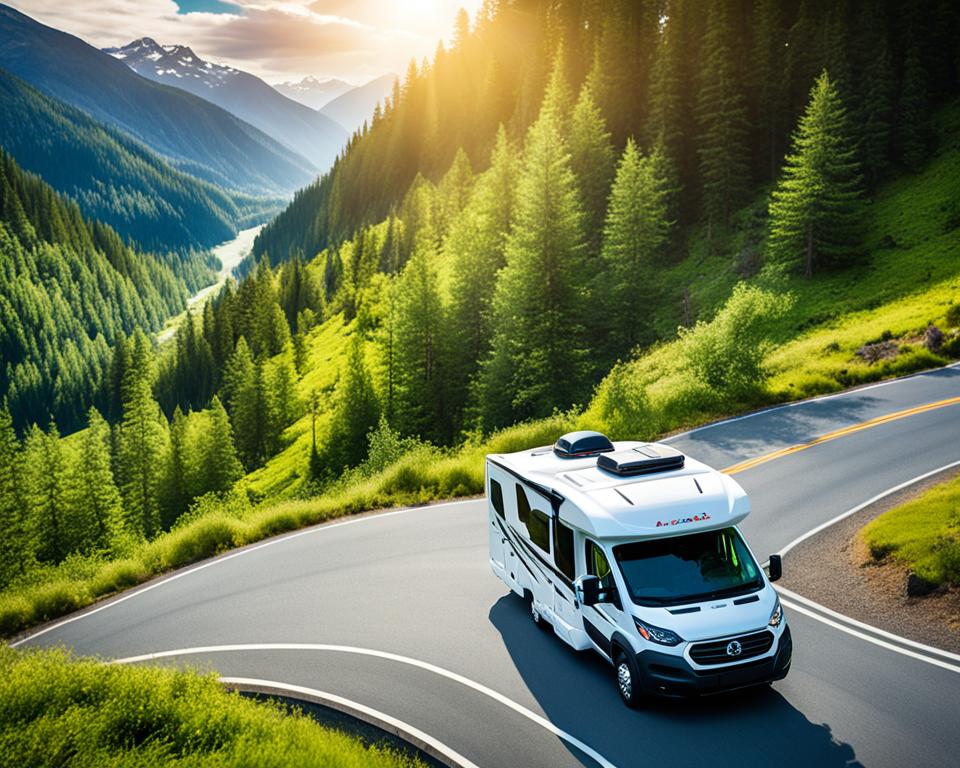
“Travel with peace of mind in a Class B motorhome. Their safety features, fuel efficiency, and compact size make them the perfect choice for adventurous travelers.”
Class C Motorhomes: Safer than Class A
When it comes to motorhome safety, Class C motorhomes offer a compelling option for travelers. These motorhomes, built on a cutaway chassis, provide a safer alternative to Class A motorhomes. Equipped with front and side airbags, seatbelts, and stability control systems, Class C motorhomes prioritize your safety on the road.
With an over-the-cab sleeping area, Class C motorhomes optimize space and efficiency. They also come with a range of amenities, such as a full bath, folding sofas/beds, and convertible dinettes, ensuring a comfortable and enjoyable travel experience.
It’s important to note that safety features and ratings can vary among different brands and models of Class C motorhomes. When choosing a Class C motorhome, research and compare safety features, crash ratings, and customer reviews to find the safest option for your travel needs.
As you plan your motorhome adventure, prioritize motorhome safety. Whether you choose a Class C motorhome, Class B camper van, or Class A motorhome, always ensure that safety features and crash ratings meet your expectations. Secure loose items, wear seatbelts, and practice safe driving to make the most of your journey.
Recommended Brands for Safe Motorhomes
When it comes to motorhome safety, choosing the right brand is essential. Several well-known manufacturers prioritize safety and offer a range of motorhome models with advanced safety features and certifications. If you’re looking for the safest RV brands, consider these top options:
- Winnebago
- Coachmen
- Jayco
- Fleetwood
- Forester
- Thor
These brands have built a reputation for their commitment to safety and often exceed industry standards and practices. When researching and comparing motorhomes, pay close attention to safety features, customer reviews, and crash test ratings. By choosing a motorhome from these recommended brands, you can have peace of mind knowing that your safety is a top priority.
Importance of Seat Belt Usage and State Laws
The use of seat belts is crucial for motorhome safety. While Class A motorhomes are not required to meet federal seat belt standards, most come equipped with seat belts from the factory. State laws regarding seat belt usage in motorhomes vary, with some states requiring all occupants to buckle up, while others only require seat belt usage for the driver and front-seat passenger.
It’s important to familiarize yourself with the seat belt laws in the states you plan to travel through and ensure that all occupants are properly restrained while on the road.
Seat belts play a vital role in protecting occupants in the event of a collision or sudden stop. They help prevent ejection from the motorhome and minimize the risk of serious injuries. By wearing seat belts, you protect yourself and your passengers, enhancing overall motorhome safety.
| State | Seat Belt Laws in Motorhomes |
|---|---|
| California | All occupants must wear seat belts. |
| Florida | Seat belt usage is only required for the driver and front-seat passenger. |
| Texas | Seat belt usage is only required for the driver and front-seat passenger. |
| New York | All occupants must wear seat belts. |
| Michigan | All occupants must wear seat belts. |
Note: The above table provides examples of seat belt laws in some states and should not be considered an exhaustive list. It’s important to check the specific seat belt laws of each state you plan to travel in.
Ensuring that all occupants, including yourself, are properly restrained with seat belts is a simple yet effective way to enhance motorhome safety. It reduces the risk of injuries and increases the chances of a safe and secure travel experience.
Conclusion
When it comes to motorhome safety, choosing the right type of motorhome and considering safety features and crash ratings are crucial. Class B motorhomes, built on commercial van frames, are generally considered the safest option due to their tested frames, safety features, and ease of driving. With front and side airbags, seatbelts, and stability control systems, Class B motorhomes offer peace of mind while on the road.
Class C motorhomes can also provide a high level of safety, with similar safety features as Class B. These motorhomes offer a more affordable option for those looking for a spacious and well-equipped RV. However, it’s important to research and compare safety features and crash test ratings among different brands and models of Class C motorhomes.
On the other hand, Class A motorhomes, while offering a wide range of sizes and amenities, may have some safety considerations due to their size and lack of standardized materials. It’s essential to ensure tires are properly inflated and regularly inspected to prevent accidents caused by blowouts or underinflated tires. Additionally, securing passengers, especially children, with car seats is recommended for enhanced safety.
Regardless of the type of motorhome you choose, prioritizing seat belt usage, securing loose items, and following safe driving practices are crucial for a secure and enjoyable journey. By taking these motorhome safety tips into consideration, you can have peace of mind while exploring the open road in the safest motorhome for your travel needs.
FAQ
What are the factors to consider for motorhome safety?
Factors to consider for motorhome safety include crash ratings, motorhome security features, and safety certifications.
What are the types of motorhomes and their safety ratings?
The three main types of motorhomes are Class A, Class B, and Class C. Class B motorhomes are considered the safest option, while Class C motorhomes are generally safer than Class A.
What are the safety considerations for Class A motorhomes?
Class A motorhomes may have safety considerations due to their size and lack of standardized materials. It’s important to ensure proper tire maintenance and secure passengers with car seats.
Why are Class B motorhomes considered the safest option?
Class B motorhomes, also known as camper vans, are built on commercial van frames and come equipped with safety features such as airbags, seatbelts, and stability control systems.
How safe are Class C motorhomes compared to other types?
Class C motorhomes are generally considered safer than Class A motorhomes. They often come equipped with safety features such as airbags, seatbelts, and stability control systems.
Which motorhome brands are recommended for safety?
Recommended motorhome brands for safety include Winnebago, Coachmen, Jayco, Fleetwood, Forester, and Thor. These brands prioritize safety and often exceed industry standards.
What is the importance of seat belt usage in motorhomes?
Seat belt usage is crucial for motorhome safety. While regulations vary by state, it’s important to familiarize yourself with seat belt laws and ensure all occupants are properly restrained.
What is the safest motorhome option for secure traveling?
Class B motorhomes, also known as camper vans, are considered the safest option for motorhome travel due to their tested frames, safety features, and ease of driving.
What are some motorhome safety tips?
Motorhome safety tips include wearing seat belts, securing loose items inside the motorhome, and following safe driving practices when traveling.



